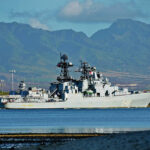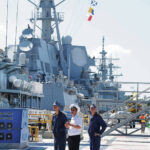Russia has its own interests in the region as the U.S. shifts its focus there from Europe


As the Trump administration pushes efforts to end the war in Ukraine and shift its attention to the Pacific, the Russian navy’s Pacific fleet has been asserting its presence.
In late March the Russian submarine Ufa, one of the Russian Pacific fleet’s newest missile subs, launched cruise missiles from a position in the Sea of Japan. The Ufa is considered one of the world’s most silent submarines, and has been reportedly referred to as a “black hole” in Russia’s submarine fleet by its rivals due to difficulty tracking the stealthy sub.
ADVERTISING
Meanwhile, U.S. Navy jets responded to a Russian spy plane flying near the American aircraft carrier USS Carl Vinson as it sailed through the Pacific on its way to the Indian Ocean for operations against Houthi militants in Yemen.
Spy planes regularly monitor the military activity of other countries, but commentators noted that released video of the incident indicated this plane was flying lower — and closer — than normal. Before making its way to the Middle East, the Vinson had been training with South Korean and Japanese forces as Seoul condemned what it called repeated airspace intrusions by the Russian military.
Though Russia has taken heavy military and economic losses since launching its full-scale invasion of Ukraine in 2022, in some ways Russian forces are also feeling a new confidence amid the bloody stalemate.
The annual U.S. intelligence community threat assessment, released in March, said that “the war in Ukraine has afforded Moscow a wealth of lessons regarding combat against Western weapons and intelligence in a large-scale war. This experience probably will challenge future U.S. defense planning, including against other adversaries with whom Moscow is sharing those lessons learned.”
Professor Yu Koizumi, an expert on the Russian military at the University of Tokyo, said the European conflict has been a drain on Russia’s military forces along its Pacific coast but that it remains a major player in the region that shouldn’t be dismissed.
“Since the war began, I have been observing the facilities of the Russian Far East military using satellite images, and the Russian military (presence) in this region has further decreased,” said Koizumi. “However, Russia is able to combine its relatively small (Pacific) military force with its political behavior to create a significant impact. In this sense, it is worth noting that the nuclear submarine and bomber forces in the Russian Far East have not decreased, and in fact the former has been strengthened.”
Russia has sought to deepen military and economic coordination with China and North Korea. In February at the Honolulu Defense Forum, an international military affairs conference hosted by the Honolulu-based Pacific Forum, U.S. Indo-Pacific Command chief Adm. Samuel Paparo referred to the three as a “triangle of troublemakers” and an “axis of autocracy” that he said threatens stability in the Pacific.
“Russia views itself as an Indo-Pacific power, with much of its territory bordering Northeast Asia,” said Kimberly Lehn, a senior director at the Pacific Forum who planned the conference. “Russia’s engagement in the region can be viewed as a means to demonstrate great-power status and counterbalance Western influence while advancing its own strategic interests.”
‘Much more active’
Russia has for some time sought to focus more on the Pacific as it looks to harvest its vast oil and natural gas reserves to export to growing economies across Asia. That interest has only grown as melting arctic ice caps potentially open up new sea routes through the Arctic linking the Pacific and Atlantic.
Koizumi said that “Europe, which was (Russia’s) largest trading partner, has reached the limits of its growth and has become a geopolitical enemy. In this context, Russia’s attention has turned to the countries of the Asia-Pacific region, which have a lot of growth potential and are not its geopolitical enemies.”
In June 2021 the Russian military launched what it called the largest exercise it had conducted in the Pacific Ocean since the end of the Cold War — 400 miles west of Hawaii with a variety of warships, anti-submarine aircraft, fighter jets and long-range bombers. Hawaii National Guard F-22 fighter jets scrambled several times to respond to Russian aircraft flying close to Hawaii’s airspace.
Since then Russian forces have been spotted conducting joint patrols with Chinese forces around Japan, the Korean Peninsula, Guam and Alaska.
Koizumi said Chinese forces operating in waters claimed by Russia like the Sea of Okhotsk, with Moscow’s blessing, changes the equation for Japan, explaining that “even if we are preparing for the threat from China, we can’t just think about the southwest of Japan; we also need to look to the north. Russia has made this possible.”
Lehn noted that “last year it was reported that the Chinese military exercised with Russian air and maritime forces in the Bering Sea that included ships and long-range aviation. Their military exercises have become a common practice and beg the question as to where they might cooperate next.”
Koizumi said that “the strengthening of the Russian Pacific fleet is not progressing uniformly,” and pointed out that the fleet has not received any new destroyers for 30 years and has been getting smaller warships. He said that means “the number of surface vessels in the Pacific fleet is on a downward trend. This trend is not expected to change significantly in the near future.”
But the story beneath the surface is different. An American intelligence official in Hawaii told the Honolulu Star-Advertiser that since the beginning of the Ukraine war, Russia has delivered seven new submarines to its Pacific fleet, with the Ufa arriving in 2024.
It’s not uncommon for U.S. forces to detect Russian submarines lurking beneath the surface in waters around Hawaii, according to current and former U.S. military personnel who spoke to the Star-Advertiser. American submarines also routinely conduct operations near Russian and Chinese waters.
“According to my analysis using satellite imagery, the Russian Pacific fleet’s (ballistic missile submarines) have become much more active in recent years,” said Koizumi. “In particular, in 2024 the (subs) made six patrols, the most of any year, and some of these were long voyages of more than two months. Since I began observing, the Russian Pacific fleet was most active last year.”
Despite growing military cooperation among Russia, China and North Korea, the intelligence official said Moscow “has been ungenerous with submarine technology” and has worked hard to protect those secrets. He argued that despite increased cooperation, Russia and China are not “natural allies.” In 1969 the two fought a violent, bitter border conflict, and many officials on either side distrust each other.
New strategies
But close relationships among Russian leader Vladimir Putin, Chinese leader Xi Jinping and North Korean leader Kim Jong Un have helped tighten their alliances. The war in Ukraine and sanctions against Russia by the U.S. and Europe have pushed Putin to lean into those partnerships even more.
Lehn said that “both China and North Korea have enabled Russia’s war machine to continue (in Ukraine), whether it is China purchasing oil and gas, sending technology and equipment, or North Korea sending munition and troops to fight on the front lines. These efforts have explicitly linked the Indo-Pacific to Europe and likely means Russia will be required to return any support to China and North Korea should a kinetic conflict arise in the Pacific, whether in the Taiwan Strait or on the Korean Peninsula.”
In 2023, Putin broke with years of neutrality when it came to China and Taiwan. China regards Taiwan, a self-ruled island democracy, as a rogue province, and Xi has vowed to bring it under his control by any means. After years of trading with Taiwan, Putin endorsed China’s position and officially added the island to Russia’s list of “unfriendly countries.”
In 2024 the leaders of Japan, South Korea, Australia and New Zealand traveled to Washington, D.C., for the annual NATO summit. The four aren’t NATO members, but regularly cooperate with the alliance. During the summit, the growing relationship among China, Russia and North Korea was a major point of discussion. At the same time as the summit, the militaries of several NATO counties were participating in Exercise Rim of the Pacific in Hawaii for the first time as they looked to increase Pacific engagement.
But the Trump administration’s approach to Russia has drawn concern — and in some cases bafflement — from traditional American allies. Trump has repeatedly criticized Ukraine, accusing Ukrainian President Volodymyr Zelenskyy of provoking Russia into invading by not “making a deal” with Russian invaders, and expressed a preference for dealing with Putin and other Russian officials whom he says he finds easier to deal with.






